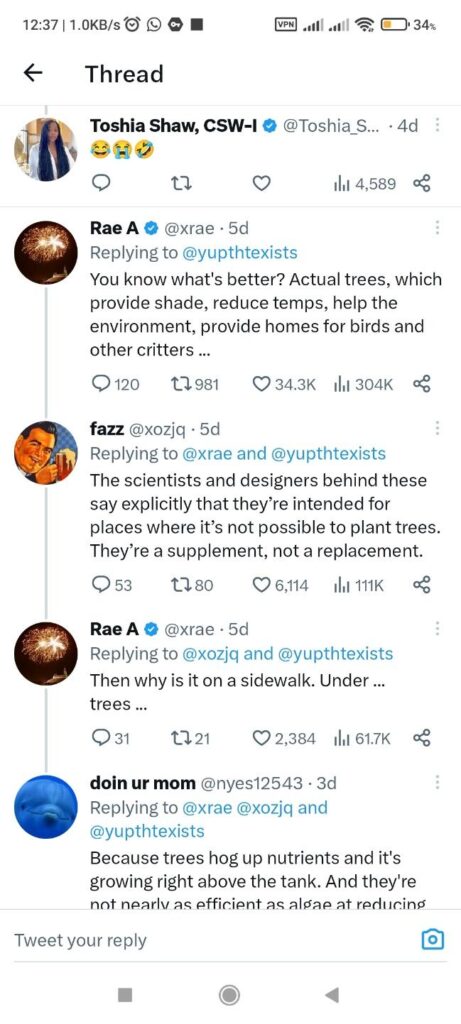It contains six hundred litres of water and uses microalgae to bind carbon dioxide and produce pure oxygen through photosynthesis.
Belgrade has an innovative tool in the fight against dirty air - this so-called "liquid tree".
It's Serbia's first urban photo-bioreactor, a solution for tackling greenhouse gas emissions and improving air quality.
It contains six hundred litres of water and uses microalgae to bind carbon dioxide and produce pure oxygen through photosynthesis.
“The microalgae replaces two, 10-year-old trees or 200 square metres of lawn," said Dr Ivan Spasojevic, one of the authors of the project from the Institute for Multidisciplinary Research at the University of Belgrade.
"The system is the same because both trees and grass perform photosynthesis and bind carbon dioxide.
"The advantage of microalgae is that they are 10 to 50 times more efficient than trees.
"Our goal is not to replace forests but to use this system to fill those urban pockets where there is no space for planting trees."
Belgrade is the fourth most polluted city in Serbia, due to the two large coal power plants nearby.
The two plants are among the top 10 dirtiest plants in Europe, according to the European NGO Health and Environment Alliance (HEAL).
In 2019, Serbia ranked as Europe's fifth most polluted country with an average PM 2.5 in air pollution, according to the IQAir's World Air Quality Report.
Another report in December 2019 also put the country under increased scrutiny, as scientists claimed Serbia had Europe's worst per capita record for pollution-related deaths: 175 per 100,000 people.
Activists have also claimed that pollution in Serbia and in other parts of the Balkan peninsula is so bad that it can be seen, smelt and even tasted, especially during autumn and winter.
Nikola commented 2 years ago:
This is like trying to fight a tornado by throwing pebbles at it. One fancy air purifier isn't going to make any difference, when practically every city here in Serbia has sky-high pollution rates. What we should really do is start phasing out coal power plants and instead turn to gas as a primary source of energy since that's our only viable option at the moment. But unfortunately, the Serbian government is way too corrupt and inexperienced to start any sort of useful project, like the one mentioned above. All they care about is making a profit for themselves and their investor friends. This leaves people prone to serious illnesses and increases the rate at which the climate change is progressing forward.
Practicality of Liquid Trees in the Battle against Air Pollution & Climate Change
Internet was much hyped over the last couple of weeks over the concept of “Liquid Trees” and their potential as carbon sinks for densely populated cities. Social Media space was also abuzz with this interesting alternative to large trees.
“Let us save trees; we love trees,” were the comments in reply to a striking tweet circulated last week. This tweet went viral, passing views of 58.1M on Twitter. It says scientists have created liquid trees as an alternative to trees in urban areas using fluid and microalga, as seen below.

However, how practical is it to actually replace real trees with so-called ‘liquid trees’? We also had the same question; hence we investigated this further.
What are Liquid Trees, and how do they work?
This innovative green idea has come from Serbian biophysical scientist Dr. Ivan Spasojevic and the project’s authors from the Institute for Multidisciplinary Research at the University of Belgrade. They have developed an incredible new tool called “Liquid tree” short for “Liquid 3” to combat air pollution. This short form is sweet and suitable because many people misinterpreted this concept because of the word “Tree.”
‘Liquid 3’ is a photo-bioreactor made using microscopic fibers in plant cell walls called cellulose nanofibers. Scientists have processed these fibers into a liquid form and made out a substance with equivalent properties to natural wood, including high strength and toughness. Tanks are filled with six hundred liters of water and microalgae. These microalgae convert carbon dioxide into pure oxygen through photosynthesis. It is estimated that liquid3 can remove as much carbon as a 10-year-old tree. On the other hand, thriving algae are used to generate energy. Liquid3 has a solar roof that uses dead biomass of algae.
Urbanization – liquid3 vs. real tree
Liquid 3 is a concept created for cities with a limited area of high air pollution with fewer trees. Unfortunately, we saw different misinterpreted tweets shared promoting liquid3 as a replacement for actual trees. Here are some of those tweets.


Therefore, we looked into the insights of an expert in the field.
Naturalist Mr. Aruna Padmapermuma
Naturalist Mr. Aruna Padmapermuma explains that “adult trees (of more than 10yrs) are the most efficient in controlling the amount of carbon dioxide in a city. However, many challenges are faced when placing trees in a city.”
“On the other hand, allergies, asthma, and hay fever can spread faster because of city tree pollen. The functions of ‘liquid3’ are similar to that of trees and grass. Yet, it is more efficient than trees because of the ability of microalgae to survive in polluted environments. Trees are more sensitive to polluted environments compared to microalgae.
Liquid3 is placed in areas where trees cannot be planted, like shopping malls, highways, and busy areas, with limited space. Owners of Liquid3 stated that microalgae are more resistant to heavy metals than trees. Their biomass analysis found that microalgae clean 300 to 3,000 cubic meters of air from heavy metals, which is relatively high.
However, we want to prioritize the research of floral species, which take CO2 typically higher than other plants like the Sansevieria family, which are easily planted in cities, Mr. Aruna added.
City trees have so much more value. They add natural character to our cities and towns and provide us with colors, flowers, and beautiful shapes, forms, and textures while giving us a feeling of relaxation and well-being; trees reduce noise pollution and increase economic stability such as tourism; trees also attract wildlife and diversity which generally cannot be achieved using liquid3 or any other artificial concept.
However, liquid 3 is a good initiative for the climate crisis, which we should overcome immediately. Innovation and critical thinking are paramount to mitigating climate change,” Mr.Aruna says.
Therefore, it is essential to place trees parallel with liquid 3 wherever possible. Because healthy, well-maintained trees can benefit from improved air and water quality, reducing energy costs and increasing property value. Click here, Archived, for more information.
The financial cost request of liquid3 vs. real tree
Through our analysis, we found that people were concerned about the production and maintenance cost of liquid 3. Here are some tweets.

We managed to find the approximate production cost of Liquid 3. However, it can be a considerable amount. Liquid 3 bioreactor walls can be made from various plant sources, including waste materials from the forestry and agricultural industries. This makes the casings a highly sustainable and environmentally friendly alternative to traditional materials.
One of the critical advantages of liquid trees is that they can be easily handled. In addition, we can make a liquid tree in any shape because of its flexibility to be molded into any shape or size, making them highly versatile and adaptable for various applications.
In contrast, the facility requires more maintenance. Every month the amount of water with microalgae has to be changed almost entirely, and the biomass has to be removed. Balken Green News reported that the designer of Liquid 3, Ivan Spasojević says currently, the monthly maintenance for the handmade prototype costs around EUR 60 per month. Hence, the maintenance cost is relatively high. Click here, Archived, to find out more.
The cost of planting a tree requires soil, fertilizers, plant, water and labour costs. As well, tree maintenance refers to the regular upkeep of trees, including pruning, watering, fertilizing, and pest control, among other things. Maintaining trees promotes their health and longevity and enhances their aesthetic value.
The cost of maintaining trees varies depending on several factors, such as the size of the tree, the type of tree, the location, and the level of maintenance required also it’s vary from region to region. For example, maintaining a large tree may be more expensive than maintaining a smaller tree, and certain types of trees may require more maintenance than others.
In general, the cost of tree maintenance can range from a few hundred dollars to several thousand dollars per year. This cost may include professional tree care services and necessary equipment, supplies, and labour.
Modern tree placement techniques.
Root balling is a concept that does not require surrounding soil or deep soil. Instead, the root ball of the tree is shaped and wrapped. Generally, trees with shallow roots require a “flatter” ball, and those with deeply penetrating roots need a deeper ball with a smaller circumference. The preferred diameter of a root ball is about four times the trunk’s diameter. The generally recommended depth of a root ball is 1.0m. Get more info here, Archived. This technique also can use to place trees in urban areas. However, trees still require more space than liquid3. Nevertheless, the benefit of root ball trees is that they can be fitted into a limited space.
How can Liquid3 help mitigate climate change?
Some potential strategies to mitigate climate change include reducing greenhouse gas emissions, which include transitioning to renewable energy sources, improving energy efficiency, reducing emissions from transportation, and reducing emissions from industries.
Furthermore, carbon capture and storage are of paramount importance. This technology involves capturing carbon dioxide from industrial processes or the atmosphere and storing it underground or in other long-term storage facilities.
The central part of the liquid3 bioreactors is micro-algae, an excellent sanctifier; it can mainly remove Carbon dioxide and partly remove various pollutants such as nitrogen, phosphorus, and heavy metal ion. These greenhouse gases directly contribute to climate change since liquid3 helps mitigate climate change by reducing these particles in the air. Microalgae also release oxygen, making fresh and clean air while removing carbon dioxide.
It also contributes to generating power using renewable energy. The nanofibers used to create liquid trees are highly conductive. They are used to develop high-performance batteries and other energy storage devices. Liquid trees also create highly efficient solar panels and other renewable energy technologies. For more information, click here, Archived. Renewable energy usually tops the list of changes the world can implement to stave off the worst effects of rising temperatures. Liquid3 bioreactors have given solutions to mitigate climate change to some extent.
In conclusion
Liquid 3 is a bioreactor that consists of water, fluid, and microalgae. Microalgae can absorb carbon dioxide and release oxygen into the atmosphere, also removing greenhouse gases to some extent, helping reduce greenhouse gases in the air. Liquid3 is an entirely new biotechnological air purification solution that mitigates climate change. However, liquid 3 is not a replacement for a real tree. Trees provide many more services on the planet, which technical tools cannot replace. Liquid 3 is a good mitigation tool to combat climate change and purify the air in urban areas. However, prioritizing trees in parallel with liquid3 is more advantageous.

No comments:
Post a Comment